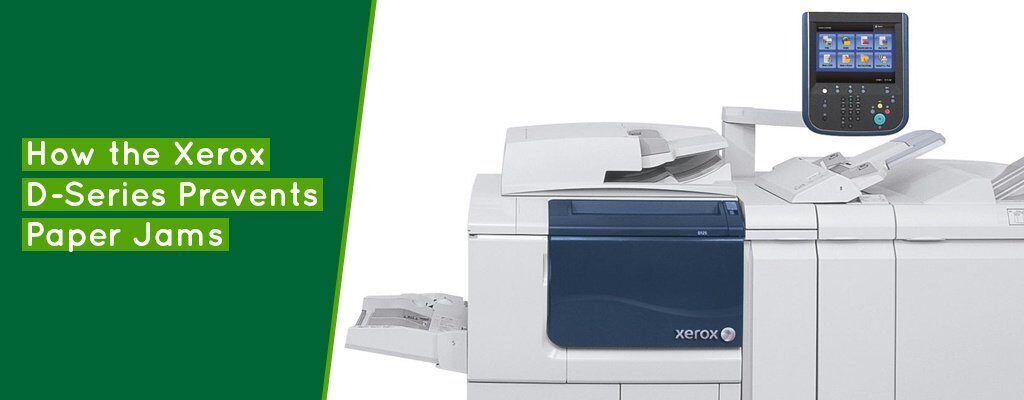How the Xerox D-Series Prevents Paper Jams
Contents
Paper jams are the bane of any printer owner. However, the Xerox D-Series is great at preventing paper jams.
The situation is a common one – right when you least expect it, a piece of paper inside your printer ends up in a place it shouldn’t be and production grinds to a halt. It often seems like the paper prefers to jam when you have a tight deadline or a huge project to finish.
Paper jams are such a commonplace frustration that commercial rage rooms have begun to offer people the ability to reenact the famous printer destruction scene in the 1996 film Office Space – one such room goes through 15 printers a week.
But printer manufacturers are continually improving paper path mechanisms to prevent jams and accommodate ever-increasing project volumes. Printer engineers see paper jams as critical opportunities for innovation that combine physics, chemistry, programming, and mechanical engineering to deliver value.
While home-office desktop printer jams are usually relatively painless problems to fix, resolving a paper jam in a 600-pound high-volume production printer is a more intimidating problem. This is why Xerox engineers have placed a high priority on engineering the D-series to eliminate paper jams.
Why Do Paper Jams Happen in the First Place?
In order to understand how the Xerox D-Series handles paper jams, it’s important to cover what paper jams are and why they happen. In most cases, the printer itself is not to blame for the jam – more often than not, it’s the paper that’s at fault.
Although we treat it like one, paper is not a manufactured product. It is a processed natural product. Paper mills make paper out of trees, and various mills around the world start with different tree species, use different techniques to create wood pulp, and bleach and process the wood pulp in different ways.
The mere fact that different trees are used around the world is enough to make it a small miracle that copy paper can achieve any degree of consistency at all. In Kentucky, paper is made from Southern Pine, whereas in Spain, paper mills use eucalyptus trees.
The process of bleaching and pressing wood pulp to make paper is not a very robust one. It’s no secret that paper is fragile. It disintegrates when it gets wet, and crumbles when it gets too dry. A device like a Xerox digital production printer has to be able to conform to these limitations while being able to reliably churn out a hundred pages per minute.
Paper quality can even change from individual sheets cut from the same roll. While the center of a roll of paper will typically feature evenly organized fibers, those fibers typically become increasingly disorganized around the edges of the roll. A large-scale production-quality printer needs to be able to adjust for minute differences in paper quality while delivering consistent results.
Paper Jams and the Xerox D-Series
The Xerox D-Series supports media weights of between 16 and 140-pound bond paper. It can handle document folders, tabs, labels, coated stock paper, and more. It features a carefully engineered interior paper path designed to accommodate all of these different types of paper with extreme speed and accuracy.
In order to reliably process such widely varying paper types, Xerox engineers have outfitted the D-series with a range of decurling options.
Since paper readily responds to environmental factors like humidity, it sometimes needs to be decurled during the print process. Paper curl is one of the leading causes of paper jams, since the slight bending of a nominally flat sheet of paper can lead to it not following the printer’s paper path correctly.
The D-series Interface Cooling Module contains a seven-setting paper decurler with preset settings that can counteract undesired curling. It offers three levels of upwards curl correction, three levels of downwards curl correction, and a neutral setting. This process prepares paper for the rest of the printing process, vastly reducing the risk of paper jams at later stages in the print process.
Can Paper Jams Still Occur in the D-Series?
Print engineers disagree on whether printer jams are permanently solvable or not. Most agree that until someone invents perfectly synthesized paper with flawless internal geometry, paper jams will occasionally occur.
High quality printing systems like the Xerox D-Series can vastly reduce the risk of paper jams, but no printer system can eliminate the risk completely.
Fortunately, Xerox has engineered the D-series to respond to common paper jams with easy-to-understand fault codes that inform users how to resolve the issue quickly. Clearing a paper jam on a Xerox D-95 or Xerox D-125 multifunction printer is surprisingly easy. In most cases, an employee can resolve the issue in mere minutes and get the print order back up and running with almost no downtime.
Interested in learning how a Xerox D-Series printer can reduce or eliminate paper jams at your facility? Contact us and speak to a printer specialist to find out.



